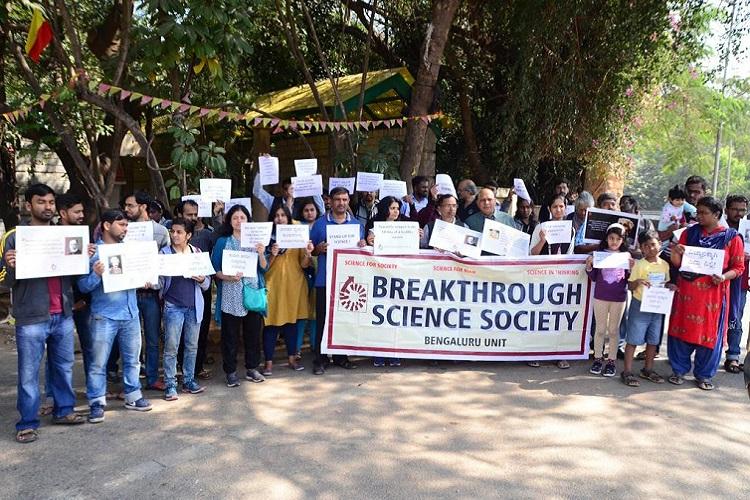At the 106th Indian Science Congress in Jalandhar, it was stated that Kauravas were test tube babies, Ravana had 24 types of aircraft including Pushpak Viman, Sudarshana Chakra is an example of guided missile technology and that gravitational waves should be renamed to ‘Modi’ waves.

Bengaluru: A number of IT professionals, teachers, students and members of the scientific community stood in protest outside the Indian Institute of Science in Bengaluru on Sunday. They held placards that made their intention clear, which was to criticise the speeches at 106th Indian Science Congress being held at Punjab’s Lovely Professional University.
Their placards had slogans like “Do not denigrate Science in India”, “Stop spreading unscientific ideas in the name of science”, “Do not mix mythology with science”, “Defending science in India is true patriotism”, “Scientific temper is the lifeline of a healthy society.”
They condemned the irrational statements made at the Indian Science Congress such as Kauravas were test tube babies, Ravana had 24 types of aircraft including Pushpak Viman, Sudarshana Chakra is an example of guided missile technology by Andhra University Vice-Chancellor G Nageswara on Friday at the event.
Leading the demonstrators were Indian Institute of Astrophysics Professor Jayanth Murthy, State President of Breakthrough Science Society Sathish Kumar G among others.
The protest was held by Breakthrough Science Society in association with All India Peoples Science Network, Akhila Karnataka Vicharavadigala Vedike and other like-minded rationalist organisations.
In a statement, BBS on Saturday said, “Puranic verses and epics are poetic, enjoyable, contain moral elements and rich in imagination, but not scientifically constructed or validated theories.”
It added, “It is absolutely distressing that these claims were made in the Children Science Congress section of Indian Science Congress (ISC) where the audience was largely comprised of teachers and young students.”
In a statement, BBS said, “…A hallowed assembly of scientists has been misused to make false and chauvinistic claims about ancient India tarnishing the genuine contributions of the great science personalities of yore and that too, in front of young and impressionable minds.”
It added, “It is important to note that no technological accomplishment can be made without the relevant scientific theoretical foundation. For instance, construction of guided missiles requires electricity, metallurgy, mechanics, projectile motion, radars, optics, motion sensors, wireless communication etc. and there is no evidence for the existence of these underlying pillars of scientific knowledge in ancient India.”
The statements made on Friday at the ISC by Andhra University Vice-Chancellor G Nageshwar Rao and another speaker Kannan Krishnan at the Indian Science Congress held from January 3-6 on had triggered strong reactions.
While Nageshwar Rao claimed ancient India had test tube babies, stem cell research among other technical innovations, Krishnan claimed that theories of ace stalwarts like Albert Einstein, Isaac Newton and Stephen Hawking were wrong.
Many believe under Narendra Modi’s Hindu nationalist BJP party, pseudoscience has moved from the fringe to the mainstream. “Modi himself set the tone in 2014 with his outlandish claim that cosmetic surgery was practised in India thousands of years ago. Many of his ministers followed suit with similar claims. India’s top science summit also started inviting academics with Hindu nationalist leanings who have made equally bizarre claims. Such claims usually hark back to an imagined glorious Hindu past to bolster religious nationalism. The BJP and its hard-line allies have, for a long time, mixed mythology and religion to bolster political Hinduism and nationalism. Adding science to the mix, say critics, will only help propagate quack science and erode scientific temper,” a BBC report said.
Also, as economist Kaushik Basu says, “For a nation to progress it is important for people to spend time on science, mathematics and literature instead of spending time showing that 5,000 years ago their ancestors did science, mathematics and literature.”
With only 10 Indian scientists featuring in the list of 4,000 highly-cited researchers across the globe, the country lags far behind China in new contributions towards science and innovation, said a recent report by Clarivate Analytics — a company that names people with multiple papers ranking in the top 1% by citations for their field and year.
Interestingly, most of the science experts listed do not come from highly ranked institutes in India that are always creating buzz for their scientific innovation. However, a professor from each IIT-Kanpur, IIT Madras, JNU, and NIT-Bhopal are on the global list.
Meanwhile, China is among the top three countries with 482 science experts. India couldn’t even make it up to the top 10 countries.
Sweden (53%), Austria (53%), Singapore (47%), Denmark (47%), China (43%) and South Korea (42%) are among the nations that have 40% of their Highly Cited Researchers selected in the cross-field category.
